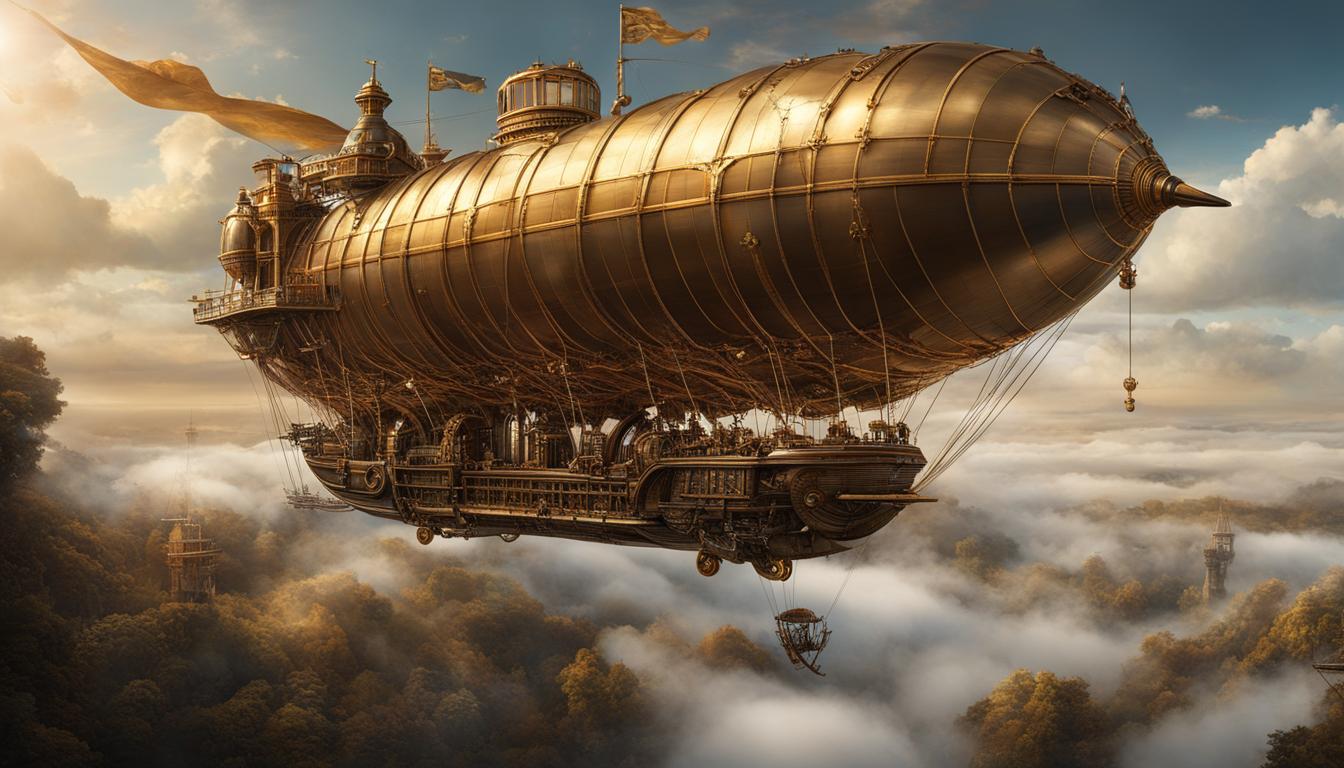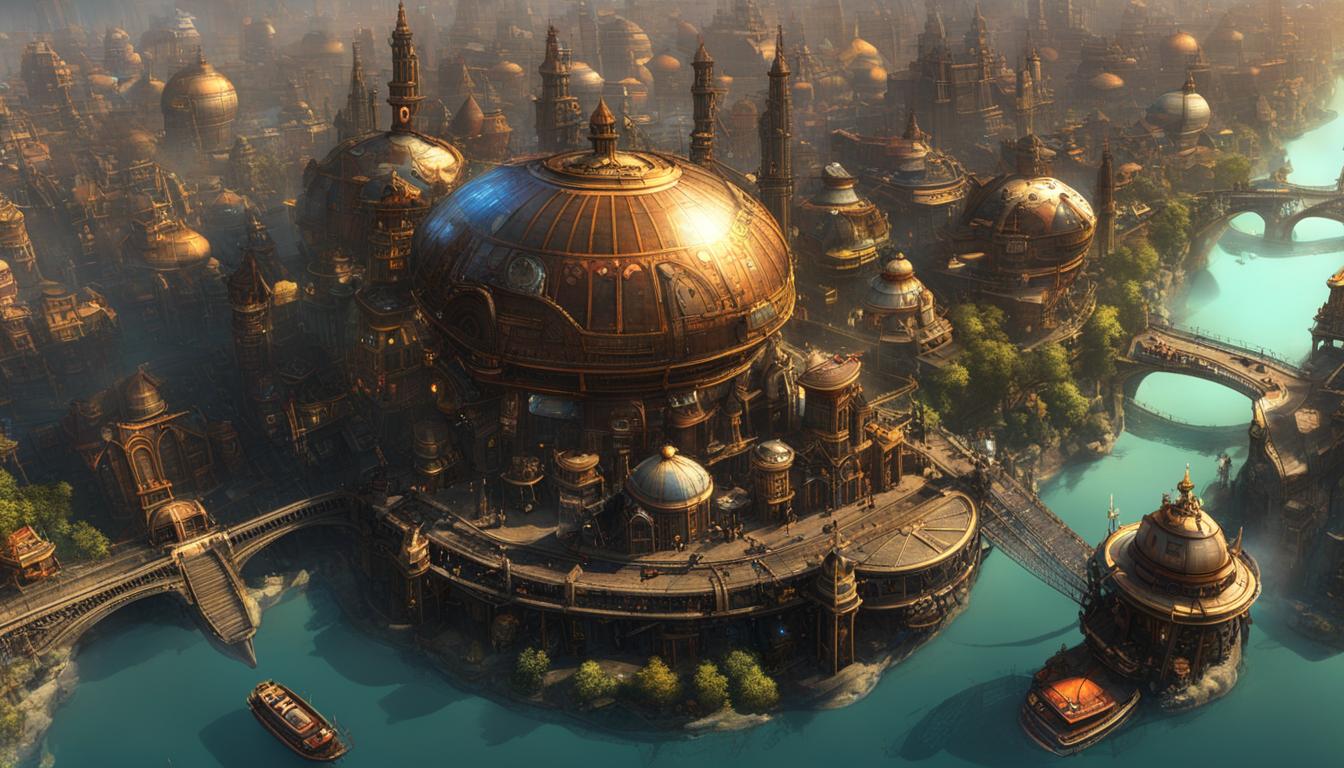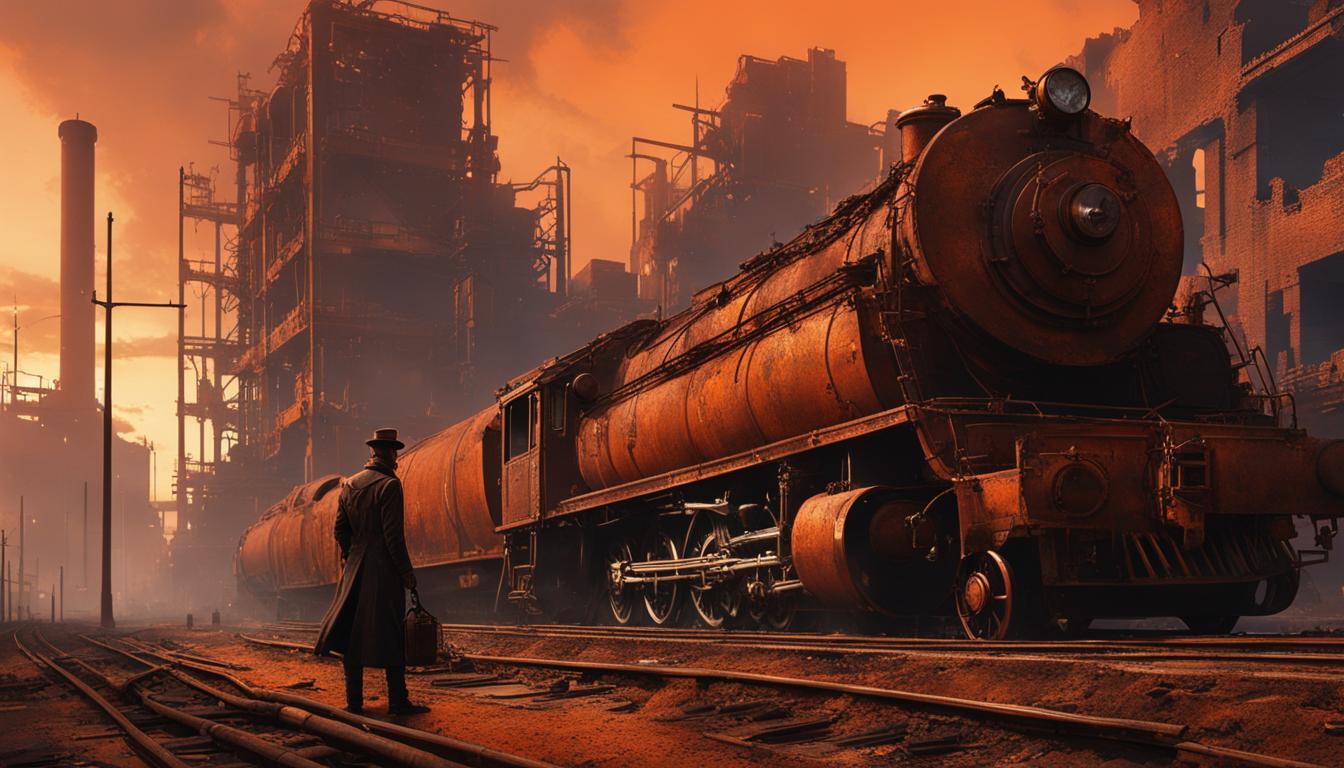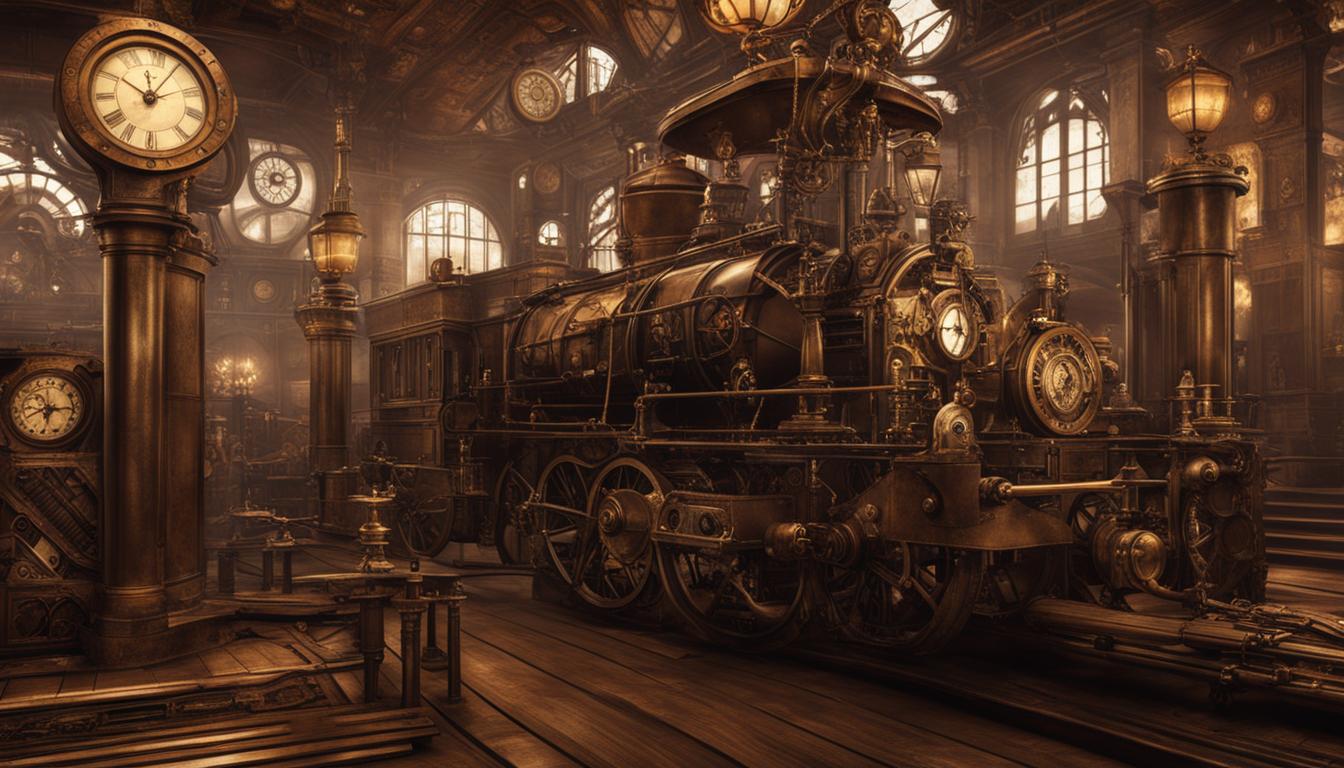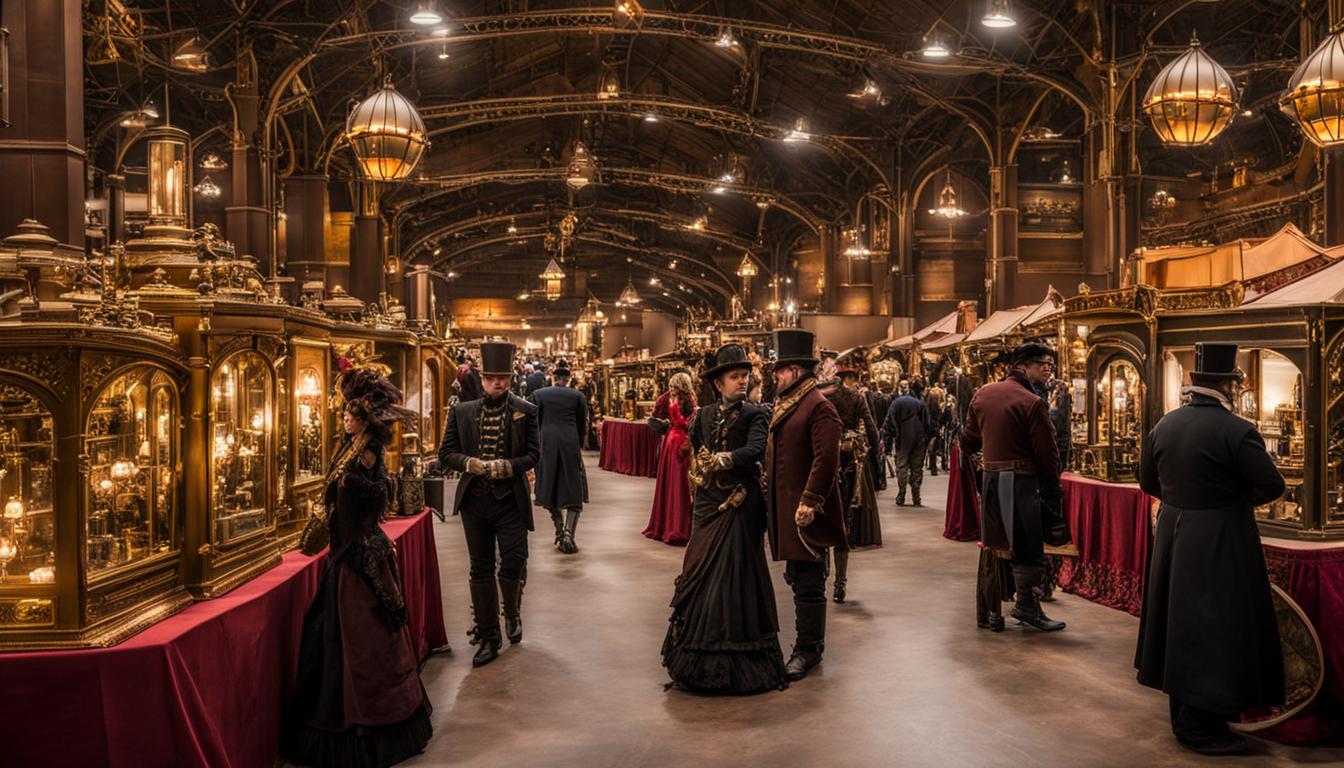Steampunk, a subgenre of science fiction, has carved a unique niche in the world of speculative fiction by blending retrofuturistic technology and aesthetics with captivating storytelling. With its roots in the 19th-century industrial era, steampunk transports readers to alternative histories and fantastical worlds, where steam-powered machinery reigns supreme.
Inspired by literary giants such as H. G. Wells and Jules Verne, steampunk offers a delightful fusion of imagination, adventure, and anachronistic inventions. But its influence extends beyond literature, permeating popular culture and bringing forth a subculture of devoted enthusiasts and artists.
Key Takeaways:
- Steampunk combines retrofuturistic technology with the aesthetics of the 19th century.
- It draws inspiration from authors like H. G. Wells and Jules Verne.
- Steampunk has evolved as a subgenre, incorporating elements from fantasy, horror, and historical fiction.
- Its impact on popular culture can be seen in art, fashion, and films.
- Steampunk storytelling provides a unique blend of adventure, social commentary, and visual splendor.
The Origins and Influences of Steampunk
Steampunk emerged as a genre heavily influenced by the works of renowned authors Jules Verne and H.G. Wells. These pioneers of 19th-century scientific romances introduced imaginative technologies and thrilling adventures set in Victorian-era contexts. The term “steampunk” itself was coined by author K. W. Jeter in the 1980s as a variant of the cyberpunk genre.
“Steampunk is what happens when goths discover brown.” – Jess Nevins
The aesthetic of steampunk draws inspiration from the Victorian era, encompassing fashion, culture, architecture, and art. It celebrates the blending of old-world charm with anachronistic technologies, creating a unique fusion of past, present, and future. Steampunk is not limited to science fiction, often incorporating elements from genres such as fantasy, horror, and alternate history, making it a truly versatile and hybrid genre.
The Influence of Jules Verne and H.G. Wells
Jules Verne and H.G. Wells laid the foundation for steampunk through their imaginative storytelling and visionary ideas. Verne’s novels, such as “Twenty Thousand Leagues Under the Sea” and “Journey to the Center of the Earth,” showcased futuristic technologies like submarines and time machines, capturing the public’s imagination.
Wells, on the other hand, explored themes of time travel and the consequences of scientific advancement in works like “The Time Machine” and “The War of the Worlds.” These authors paved the way for steampunk to reimagine the possibilities of the Victorian era, inspiring countless authors, artists, and creators to bring the genre to life in various mediums.
| Influences | Originators |
|---|---|
| Victorian era culture and aesthetics | 19th-century scientific romances by Jules Verne and H.G. Wells |
| Cyberpunk genre | Coined by K. W. Jeter in the 1980s |
| Alternate history and fantasy | Diverse range of authors and creators |
The Evolution of Steampunk in Literature
In the world of literature, steampunk has evolved from its early pioneers to become a thriving and influential genre. The movement began in the 1980s with authors like Tim Powers, James Blaylock, and K. W. Jeter. Their novels, such as “The Anubis Gates,” “Lord Kelvin’s Machine,” and “Morlock Night,” introduced readers to alternative Victorian worlds filled with advanced technology and fantastical elements. These works laid the foundation for the genre’s unique storytelling and imaginative settings.
Since then, numerous notable authors have made their mark in steampunk literature. Michael Moorcock’s “The Warlord of the Air” and Neal Stephenson’s “The Diamond Age” are just a few examples of influential steampunk novels that have captivated readers with their blend of history and invention. Michael Chabon’s “The Yiddish Policemen’s Union” also showcases the genre’s ability to explore social issues within an imaginative and thrilling narrative.
Steampunk storytelling is characterized by its ability to transport readers to a time and place that never was, combining elements of historical fiction, fantasy, and science fiction. The genre offers a unique blend of nostalgia for the past and a vision of a future that never came to be. Through richly detailed worlds and intricate plots, steampunk literature continues to engage and inspire readers, inviting them to explore a realm where imagination knows no bounds.
| Notable Steampunk Novels | Author |
|---|---|
| “The Anubis Gates” | Tim Powers |
| “Lord Kelvin’s Machine” | James Blaylock |
| “Morlock Night” | K. W. Jeter |
| “The Warlord of the Air” | Michael Moorcock |
| “The Diamond Age” | Neal Stephenson |
| “The Yiddish Policemen’s Union” | Michael Chabon |
Table: Notable Steampunk Novels and Their Authors
Steampunk in Popular Culture
The subgenre of steampunk has not only captured the imaginations of authors and readers but has also found its place in popular culture. Steampunk has evolved into a subculture, complete with its own fashion trends, art, and design. From fashion enthusiasts to visual artists, the steampunk subculture has expanded its influence beyond the pages of books.
Steampunk Fashion
One of the most distinctive aspects of the steampunk subculture is its fashion. Steampunk enthusiasts often blend Victorian-era styles with modern elements and anachronistic accessories. Women may be seen wearing corsets, bustle skirts, and lace-up boots, while men may don waistcoats, top hats, and goggles. The fashion of the steampunk subculture embraces individuality, creativity, and a sense of adventure.
“Steampunk fashion allows individuals to express their love for the past and their fascination with the future. It’s a unique blend of history, imagination, and personal style.” – Fashion enthusiast
Steampunk Art and Design
The aesthetics of steampunk have also found their way into various forms of visual arts. Artists are inspired by the intricate mechanisms, gears, and Victorian motifs that define the genre. Steampunk art often blends the elegance of the past with the possibilities of futuristic technology. It can be seen in paintings, sculptures, and even handcrafted jewelry.
Designers have also incorporated steampunk elements into everyday objects, transforming them into functional works of art. From steampunk-inspired furniture to custom-made timepieces, the fusion of Victorian aesthetics and imaginative technology has produced a wide range of captivating designs.
Steampunk in the Media
The influence of steampunk can be seen in various forms of entertainment. Films like Terry Gilliam’s “Brazil” and the TV series “The Wild Wild West” have embraced the steampunk aesthetic, transporting viewers to alternative worlds filled with retrofuturistic technology.
The subculture also extends to music, with bands incorporating steampunk themes and aesthetics into their performances. From industrial sounds to Victorian ballads, the music of the steampunk subculture offers a unique auditory experience.
| Steampunk Subculture | Steampunk Fashion | Steampunk Art and Design |
|---|---|---|
| Embraces individuality and creativity | Blends Victorian-era styles with modern elements | Incorporates intricate mechanisms and Victorian motifs |
| Inspired by retrofuturistic technology | Includes corsets, waistcoats, top hats, and goggles | Transforms everyday objects into functional works of art |
| Explores a sense of adventure and imagination | Showcases creativity through custom-made designs | Blends elegance of the past with possibilities of the future |
Steampunk in Speculative Storytelling
Steampunk, with its unique blend of historical aesthetics and futuristic technology, has found its way into various genres of speculative fiction. From fantasy to horror, historical fiction to alternate history, steampunk themes add depth and richness to the storytelling experience. By creating alternative worlds and exploring real-world social issues, authors can captivate readers with captivating narratives that transport them to captivating realms.
In speculative fiction genres such as fantasy, steampunk offers a fresh take on world-building. It introduces an anachronistic mix of advanced machinery, steam-powered contraptions, and Victorian-era aesthetics. This fusion creates a visually stunning atmosphere that immerses readers in a world both familiar and fantastical. Authors like China Miéville, with his “Bas-Lag” series, have brought steampunk elements into the realm of urban fantasy, blending Victorian technology with otherworldly creatures and intricate political landscapes.
Steampunk’s influence also extends to horror storytelling. The combination of Gothic elements and anachronistic technologies adds an eerie ambiance to tales of suspense and supernatural encounters. Authors like Cherie Priest, with her “Boneshaker” series, have successfully woven steampunk themes into horror narratives, creating a unique subgenre that both frightens and fascinates readers.
Steampunk in Alternative History
One genre that seamlessly integrates steampunk themes is alternate history. By reimagining historical events with an added technological twist, authors can explore the possibilities of what could have been. The “Leviathan” series by Scott Westerfeld, for example, presents an alternate World War I where the conflict is fought with genetically engineered creatures and advanced steampunk machinery. This blending of historical context and speculative elements offers readers a fresh and intriguing perspective on the past.
Steampunk’s versatility in speculative storytelling is evident in its ability to transcend specific genres. By infusing tales of adventure, romance, mystery, and even science fiction with its unique aesthetic, steampunk continues to captivate readers and inspire authors to push the boundaries of imagination. As the genre evolves, it is likely to find new and exciting ways to enhance the speculative storytelling experience.
| Steampunk Themes in Speculative Fiction | Speculative Fiction Genres and Steampunk |
|---|---|
| Advanced machinery and technology | Fantasy |
| Victorian aesthetics | Horror |
| Anachronistic inventions | Historical Fiction |
| Alternate history | Alternate History |
| Gothic elements |
While steampunk may have its roots in science fiction, its influence has spread far beyond the boundaries of a single genre. By infusing speculative fiction with Victorian aesthetics and anachronistic technologies, steampunk themes breathe new life into storytelling, offering readers unique and captivating narratives that blend elements of the past and the future.
Steampunk in Manga and Anime
Japanese manga and anime have fully embraced the captivating and visually stunning world of steampunk since the 1940s. Influenced by the imaginative works of European authors like Jules Verne, steampunk anime and manga present a fantastical version of an alternative Industrial Europe. These captivating narratives transport readers and viewers to an era where steam-powered machinery, clockwork contraptions, and Victorian aesthetics blend seamlessly with fantastical adventures.
One notable example of Japanese steampunk is Hayao Miyazaki’s renowned film “Castle in the Sky.” Set in a world where floating castles and flying machines exist, the film combines breathtaking animation with a captivating storyline. Another iconic contribution to the steampunk genre is the franchise “Steamboy.” Directed by Katsuhiro Otomo, the creator of the renowned “Akira,” “Steamboy” showcases an alternate Victorian London filled with intricate steam-powered machinery and riveting action sequences.
Japanese steampunk seamlessly merges the retrofuturistic elements of steampunk with the distinct visual style of manga and anime. The genre’s intricate character designs, attention to detail, and dynamic storytelling capture the imaginations of fans worldwide. With its unique blend of historical aesthetics and futuristic technology, Japanese steampunk continues to captivate audiences and inspire further exploration within the steampunk genre.
Table: Notable Japanese Steampunk Manga and Anime
| Title | Year | Genre |
|---|---|---|
| “Castle in the Sky” | 1986 | Fantasy, Adventure |
| “Steamboy” | 2004 | Action, Sci-Fi |
| “The Empire of Corpses” | 2015 | Horror, Mystery |
| “Last Exile” | 2003 | Adventure, Fantasy |
These works represent just a fraction of the rich and diverse landscape of Japanese steampunk. From immersive storytelling to stunning visuals, they offer a gateway into a world of awe-inspiring imagination and boundless creativity. Japanese steampunk continues to push the boundaries of the genre, captivating fans and inspiring new narratives within the steampunk subculture.
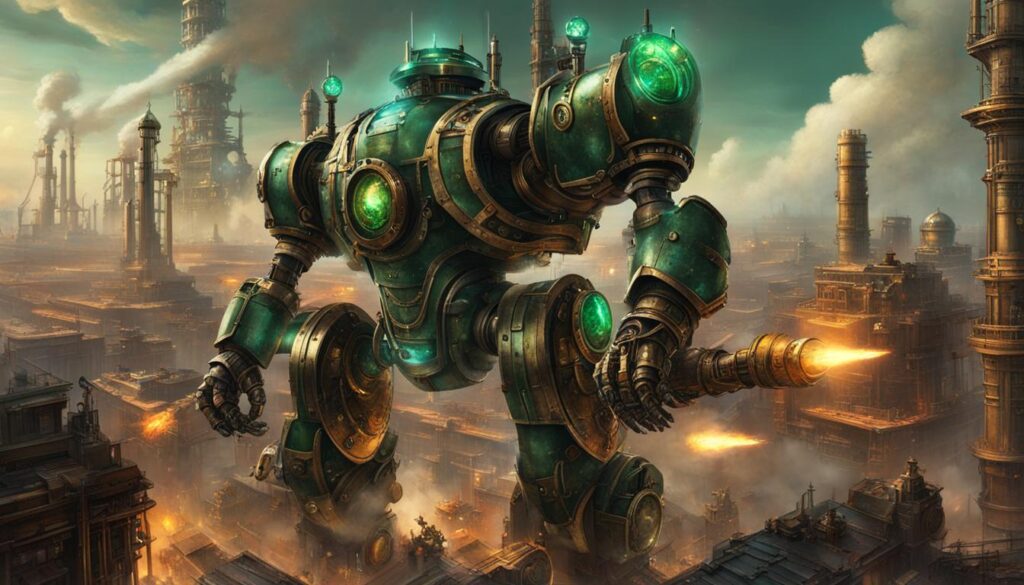
Steampunk’s Cultural Significance
Steampunk’s impact on popular culture reaches far beyond the realm of speculative fiction. It has sparked a cultural movement, capturing the imagination of enthusiasts around the world. With its unique blend of history, invention, and imagination, steampunk has become a symbol of nostalgia and a yearning for a bygone era. It represents a longing for a time when technology and craftsmanship were revered, and the elegance of the Victorian era was celebrated.
This cultural movement has inspired a wide range of artistic expression. From fashion and design to music and visual art, the steampunk aesthetic has permeated various creative spheres. People have transformed everyday objects into steampunk-style creations, infusing them with retro-futuristic charm. Artists have embraced the aesthetics of the genre, incorporating influences from Victorian-era fiction, art nouveau design, and mid-20th-century films.
Steampunk offers a unique way to reflect on modernity while transporting ourselves to an alternative past or future. It allows us to explore the possibilities of technology and society while evoking a sense of wonder and adventure.
The Impact of Steampunk’s Aesthetics
Steampunk’s cultural impact can be seen in its ability to inspire and influence various forms of expression. Its visual and thematic elements have found their way into films, television series, and video games, captivating audiences worldwide. From the dystopian world of “Brazil” to the adventurous escapades of “The Wild Wild West,” steampunk has left an indelible mark on the entertainment industry.
Furthermore, steampunk’s nostalgic appeal has resonated with individuals seeking an escape from the fast-paced, technology-driven modern world. It offers a chance to reimagine a past that never was and to explore the possibilities of a different future. Steeped in romanticism and adventure, steampunk invites us to reflect on our relationship with technology and the impact it has on society.
The Future of Steampunk
Steampunk’s cultural significance is not waning but evolving. As the genre continues to captivate audiences and inspire new works of fiction and art, its legacy will shape the future of speculative storytelling. Steampunk’s ability to blend history, invention, and imagination will push the boundaries of traditional genre conventions and challenge readers to explore new realms of possibility. With its enduring appeal, steampunk is poised to remain a beloved and influential cultural movement for years to come.
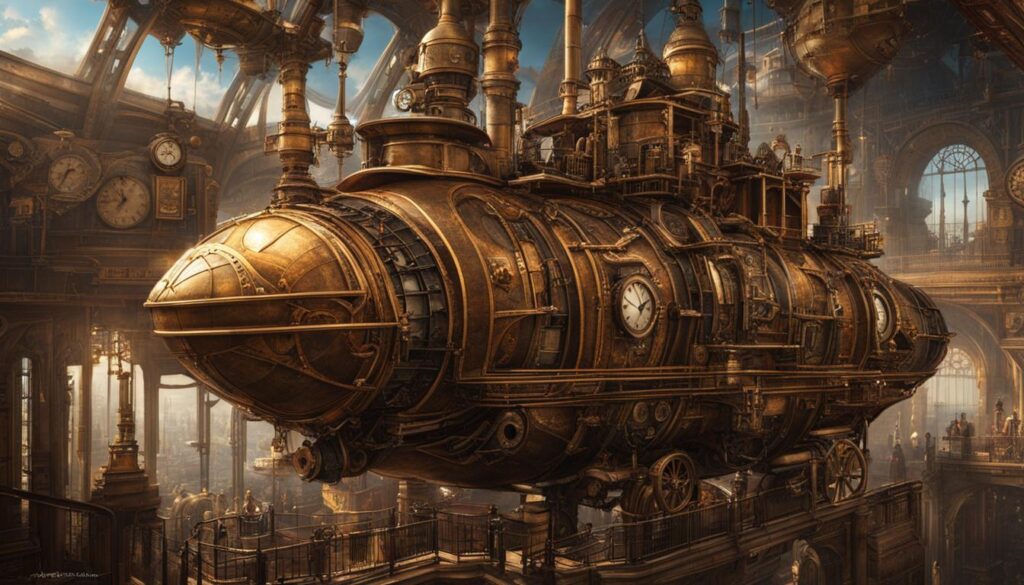
Conclusion
The legacy of steampunk in speculative fiction is undeniable. By seamlessly blending history, invention, and imagination, steampunk has carved a unique niche within the genre. Its themes and aesthetics have continuously inspired authors, artists, and fans alike, propelling the subgenre to new heights.
Looking ahead, the future of steampunk holds exciting possibilities. As the genre evolves, it will continue to push the boundaries of storytelling and challenge traditional genre conventions. Steampunk’s ability to transport readers to alternative realities will undoubtedly shape the landscape of contemporary fiction.
Steampunk’s influence extends beyond literature, permeating various forms of entertainment and creative expression. From its origins in the pages of novels to its presence in films, art, and even fashion, steampunk has become a cultural movement that sparks nostalgia while offering a fresh take on modernity.
As we embark on a journey through the gears and cogs of steampunk, one thing becomes clear: the subgenre’s impact is far from over. With its captivating blend of history and fantasy, steampunk continues to captivate audiences and inspire new realms of storytelling. The future of steampunk is bright, and it will undoubtedly leave an indelible mark on the world of literature and entertainment.
FAQ
What is steampunk?
Steampunk is a subgenre of science fiction that incorporates retrofuturistic technology and aesthetics inspired by 19th-century industrial steam-powered machinery.
What time period does steampunk take place in?
Steampunk often takes place in an alternative history of the Victorian era or the American “Wild West.”
Who are the influential authors in the steampunk genre?
Steampunk is influenced by 19th-century scientific romances of Jules Verne, H. G. Wells, and other authors.
When was the term “steampunk” first coined?
The term “steampunk” originated in the 1980s as a variant of “cyberpunk” and was coined by author K. W. Jeter.
What are some notable steampunk novels?
Some notable steampunk novels include “The Anubis Gates” by Tim Powers, “Lord Kelvin’s Machine” by James Blaylock, and “Morlock Night” by K. W. Jeter.
How has steampunk expanded beyond literature?
Steampunk has become a subculture with its own artistic styles, fashion trends, and subcultures. It has influenced visual arts, music, films, and computer games.
What genres does steampunk often intersect with?
Steampunk often intersects with genres such as fantasy, horror, historical fiction, and alternate history.
How has Japanese manga and anime embraced steampunk?
Japanese manga and anime have embraced the steampunk aesthetic since the 1940s, combining retrofuturistic elements with the distinct visual style of manga and anime.
What is the cultural significance of steampunk?
Steampunk represents a yearning for a past that never was, offering an alternative vision of the future while incorporating elements of nostalgia and reflection on modernity.
What is the future of steampunk?
Steampunk’s legacy will likely shape the future of speculative fiction, pushing the boundaries of storytelling and challenging traditional genre conventions.

